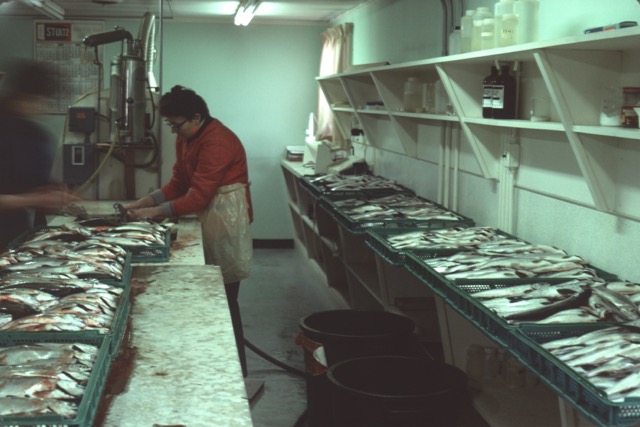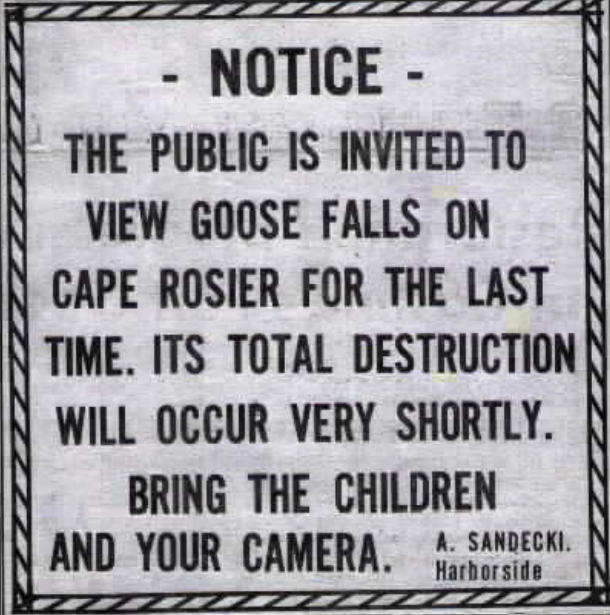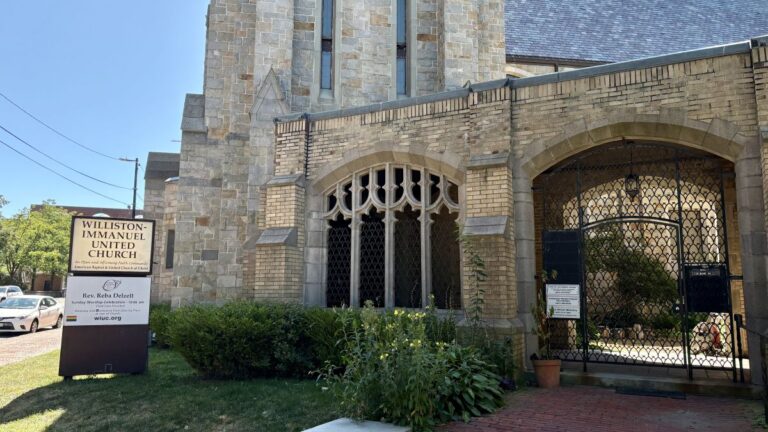The first restaurant to serve salmon raised in the flooded pit of the Callahan Mine Superfund site would be the historic Jed Prouty’s Inn and Tavern in Bucksport, biologist Bob Mant reported at a meeting of the Goose Pond Reclamation Society in the fall of 1972.
About 3,800 of the 4,200 juvenile Coho salmon had survived the summer, said Mant, and roughly half had reached a marketable size of between 10 and 12 ounces.
The 350,000 oysters that had been seeded were also growing nicely, added Mant, and seemed unbothered by the high levels of zinc in the water, which were double those in nearby Blue Hill Bay.

Mant’s experimental aquaculture project — one of the first of its kind in the state, along with an operation in Wiscasset — began just months after the last ore from the mine was extracted and the open pit was refilled with seawater.
Buildings on the site that once housed assay labs and mining equipment were now crammed with plastic trays of oyster spat and massive fiberglass vats containing thousands of salmon fry. The salmon and oysters would be started on land before being transferred to Goose Pond, where they would be suspended in nets and cages and grown to market size.
Not far from the experimental lab was the tailings pond, a massive pile of unwanted slurry at the mine site’s southern edge, on the banks of Marsh Creek. When it rained or snowed, heavy metals from the pile would leak into the creek and adjacent salt marsh — and into Goose Pond itself.


The idea for an aquaculture project in the former mine pit was the brainchild of Fred Beck, chief geologist for the Callahan Mining Corporation, who had been charged with overseeing the closure of the mine. Beck had recently traveled to Washington state, where he’d seen a pilot project run by Jon Lindbergh, son of the famous aviator Charles Lindbergh, growing salmon in Puget Sound.
“I thought that was kind of fascinating,” recalled Beck, sitting in his basement office in Yarmouth earlier this fall. “Why couldn’t the flooded open pit be used for doing net pen aquaculture, like they were doing out in Puget Sound?”
A potential deposit
Tiny, bucolic Brooksville is an unexpected place for a Superfund site. With a year-round population of less than a thousand residents, the town is perhaps better known for being the setting for Robert McCloskey’s 1952 children’s classic One Morning in Maine, or as the homestead of Helen and Scott Nearing, the revered grandparents of the back-to-the-land movement.
Famed organic farmers and authors Eliot Coleman and his wife Barbara Damrosch still live nearby, growing hardy vegetables in unheated greenhouses through the unrelenting Maine winter.
Perched on the northwest edge of Cape Rosier in the village of Harborside looking west into Penobscot Bay, Goose Pond spills out into Goose Cove, a small inlet nestled among some of Maine’s most staggeringly beautiful coastline.
Just across the water, with the tailings pond and bulldozers visible in the distance, birders have logged sightings of belted kingfishers, eagles, osprey, spotted sandpipers and hermit thrush. Walking paths thread their way through the woods on the pond’s eastern edge, now a 1,200-acre state park and nature sanctuary.

Beck came to Maine after abandoning a planned sailing trip around the world when his wife learned she was pregnant not long after the couple departed Wales.
After first taking a job with the Maine Geological Survey, Beck initially went to work as a consultant for Callahan before being hired as the company’s regional geologist. He spent his days in an office in Blue Hill, poring over old surveys and mining records, searching for unexplored or abandoned deposits and reporting his findings to the company’s office in New York.

Goose Pond was an obvious choice to go looking for a potential deposit, said Beck. The region had a history of mining going back to the late 1800s, and at one point was the state’s leading producer of base metals, with two mines, a smelter and even a stock exchange operating in Blue Hill.
The zinc and copper deposits in Harborside were discovered in the early 1880s. The Harborside Copper Mine, as it became known, produced around 10,000 tons of ore from three underground shafts between 1881 and 1883. The ore was barged across the bay to Castine, where they were piled on a dock and periodically picked up by coastal schooners to be brought to smelters in the south.
But metal prices faltered, and the boom was over almost as quickly as it began, with a final shipment of copper from the Douglass Mine in Blue Hill in 1918 marking the end of base metal mining in Maine for decades. The Harborside Copper Mine shut down in the late 1880s, and lay largely dormant until it was optioned by the Penobscot Mining Company of Toronto in 1956 and leased to Callahan a decade later.
Digging in a tidal estuary
Callahan determined that the only way to make the deposit profitable would be to extract the metals in an open pit, dug below the pond’s surface.
According to Beck, who is writing a book about the history of the Callahan Mine, the company planned to fund the project with proceeds from its Galena silver mine in northern Idaho, at the time one of the nation’s most productive silver mining operations.
The state of Maine owned the land beneath Goose Pond, which meant Callahan would need permission to drain and excavate it. Four state agencies approved Callahan’s plans and the State Supreme Court also signed off, as did lawmakers and then-Maine Governor John Reed, citing a promise of jobs and a million dollars in annual payroll. The law declared the mine to be “of public interest to the state.”
The law required Callahan to “return the water to the aforesaid tidal estuary upon termination of mining,” but made no mention of any other reclamation or funds.

A lease signed the following year between Callahan and the Maine Mining Bureau, the state agency responsible for permitting at the time, did require that the company work with the agency to rehabilitate the land. But the document had few details, requiring only that reclamation be “the subject of further discussion and negotiation between the parties.”
No money or testing of the soils was required in advance, nor was the company required to take any precautions to ensure the waste rock in the tailings pile didn’t leach toxins.
“It did give us some good jobs for three or four years, and that was it,” said John Gray, who worked as an assayer at the mine when it was in operation and whose family has lived in Brooksville for generations. “And then — I don’t think we really realized how much damage was done.”
Nationwide, mining law at the time was in its infancy. Most regulations applied only to coal mines, which had seen a number of high-profile disasters over the years. It wasn’t until 1966, the year the Maine Legislature gave Callahan approval to drain the estuary, that Congress passed a law establishing procedures for developing safety and health standards for metal and nonmetal mines. It would be another decade before The Mine Safety and Health Act was passed.
Locals in Brooksville were largely supportive of the mine, said Gray, who still lives nearby. An electrician by trade, Gray took a job at the assayer for Callahan, submerging ground rock samples in chemical baths to coax the metals out in solution, then drying them under large heaters and reporting back to the mine manager. Assayers could turn around a sample in an hour, if necessary.
“It was a pretty good job,” said Gray, akin to working at one of the larger paper mills. “It was not quite as good pay as that, but it was pretty good for the area.”

Not everyone was excited about the prospect of digging for heavy metals in a tidal estuary.
Opposition to the project was led by realist painter Albert Sandecki, who had purchased a summer home abutting the Callahan property in 1964.
In a letter shortly after the company began digging, Sandecki warned of the consequences.
“The future value of the entire area is jeopardized by the fact that the Callahan Corporation has not been required by state or local officials to provide a contract or performance bond to insure restorative measures,” Sandecki wrote.
“It is common documented knowledge from other states that open pit mines present these problems, and there is no reason to assume that this project will be any different in its resultant destruction to scenery, wildlife, and future values of the area.”
‘That’s the way it was’
After getting approval from the state, Callahan quickly set to work constructing two dams — one at the mouth of the estuary to prevent the tides from entering and another at the head of the pond to divert the fresh water drainage from 1,600 acres of adjacent forest and salt marsh. In early 1968, the company drained the water and set about digging a pit that would ultimately descend 340 feet, covering nearly 10 acres of land.
It was evident early on that the mine was creating environmental problems. Without tidal currents to periodically scour the cove, silt was settling in the area below the pond, Beck wrote in a paper in 1970.
Residents began complaining of wells going dry in the area around the pond, or being infiltrated with saltwater. Tests of clams and other shellfish in the cove revealed higher than expected heavy metal content, but since the area had not been studied in advance, there was no established baseline.
“It can only be assumed that the mine is one of the contributors,” Beck wrote.

Brooksville escaped the scourge of acid mine drainage, which can occur in base metal mines and devastate the surrounding environment, only because the metals in Harborside happened to occur in a matrix of talc carbonate, which immediately buffered any acid produced by the surrounding metals. But this was largely luck, as no testing was done in advance.
“In hindsight, of course, we see things that should have been done that weren’t by both government and industry,” said Beck.
“It’s required now by the [Maine Department of Environmental Protection] to do a lot of testing of soils, of water, of groundwater, surface water and so forth before you even dig a shovelful of dirt. But that wasn’t part of the equation back in those days. It’s too bad it wasn’t, but that’s the way it was.”
Callahan built settling ponds and a pipe to help disperse the silt and tried recycling the effluent water in the on-site processing mill, with the hopes of creating a closed system that could be a model for other underwater mines. The company also drilled new wells for those whose wells had gone dry, moving some away farther from the sea.
But the tailings pond, where unwanted slurry was dumped after metals were floated out, remained unlined on the bottom and open to the elements, allowing zinc and copper and lead to leach into the adjacent salt marsh and soils. Waste rock piles and ore processing areas had no protective lining underneath or caps on top, unthinkable under modern mining regulations.

“I’m sure there are people who think I’m an evil person,” said Beck, whose company, Maine Environmental Laboratory, now helps state agencies and nonprofits test soil and rocks for mineral content.
“I’ve always been a strong environmentalist. Most geologists, I think, are,” he said. “Callahan, I think, did their best under the conditions that existed at the time.”
A new purpose
After operating for four years and extracting 5 million tons of rock (including 800,000 tons of valuable ore), Callahan shut down the mine in Harborside, having exhausted the deposit. The company attempted some revegetation of the site, hiring a landscape renewal specialist who experimented with a variety of plants, including zinc-tolerant red fescue grasses from Wales.
But the plants struggled to take, said Beck, who had been given the unenviable task of managing the cleanup after the mine manager left for a job in Brazil.
Maine had passed a law in 1969, a year into Callahan’s operation, requiring mining companies to post bonds and submit a comprehensive site rehabilitation plan before beginning mining operations. But Callahan had been grandfathered in and was thus not required to submit any reclamation money to the state.
Callahan offered to remove the concrete dam and dredge the cove as part of the requirements of its mining lease, but state agencies initially refused, fearing that disturbing the area and allowing tidal flow would make any metal contamination worse.
Eventually, Beck said, the Department of Inland Fisheries and Wildlife agreed that part of the dam should be removed to allow for some tidal flow. Photos of the day the water flowed in show the sea cascading hundreds of feet into the mine pit, a towering, ephemeral waterfall.
Once the pond had refilled, Beck wondered whether there was a way to repurpose the mine site. The minerals leaching into the pit from the mine site were sulfides, insoluble in seawater, meaning the water itself was free from toxic metals, which Beck and his team confirmed repeatedly with tests. He wondered whether salmon might do well in the pit’s deep, cold waters.

Bob Mant, a promising young biologist trained at Princeton University and at the University of Maine, agreed to head up the project, which he named Maine Sea Farms.
In 1974, two years after the mine closed, Callahan, which had initially backed the project, struggled to find additional investors, according to documents Beck gave to The Maine Monitor, and sold the site to Mant for $25,000.
The experiment became, for a time, the largest pen salmon operation on the eastern seaboard, handling millions of fish, according to testimony Bob’s wife Linda gave to Congress in 1977. The on-site laboratory equipment was repurposed to test for metals in the fish, and Mant hired two local men to help him run the operation.
The salmon and oysters were repeatedly tested for heavy metals but found to have escaped contamination, likely because the minerals in which the metals occurred were insoluble in water, settling instead into the silt below, said Beck.
The fish were sold to restaurants as far south as Boston, said Beck, who ate a few of them himself.
But Mant was a better biologist than he was a businessman, said Beck, and struggled to keep the business afloat; Maine Sea Farms lasted just five years before going bankrupt. The equipment was sold off and the buildings eventually torn down.
For years after that the mine was mostly quiet, said Gray. People would walk through the site and pick up shiny pieces of ore, and children occasionally played on the tailings pond.
“It was kind of fun,” said Gray, “And nobody seemed to get hurt, so it was pretty good.”
A cautionary tale
In 2002, three decades after the Callahan mine closed and after many years of testing, the Environmental Protection Agency designated the former mine and salmon farm as a Superfund site. Initially funded by taxes on petroleum and chemical companies, the goal of the Superfund program was to create a dedicated fund for cleaning up hazardous waste, even when a responsible party couldn’t be identified.
Cleanup work began in Brooksville in 2011. Contaminated rock and soil was consolidated, and a new system was designed and constructed to manage the tailings. The tailings pond was stabilized and lined and a cover was installed to help prevent heavy metals from leaching out when it rains or snows.
Drainage systems were installed and erosion controls put in place, and nearby properties were rid of soil contaminated with PCBs, which are thought to have stemmed from the dumping of electrical transformers on the land after Maine Sea Farms closed.

In the intervening decades, Maine mining law changed dramatically. Companies are now required to conduct years of water and soil testing before applying for mining permits, and must set aside funds for reclamation in advance. It has been more than 40 years since the state has had any active metal mines, and many experts consider Maine to have the most stringent mining laws in the United States.
Those laws were written in large part out of a desire not to repeat what happened with Callahan. During discussion of the most recent mining law changes, which were approved earlier this year, proponents and detractors alike invoked Callahan as a cautionary tale.
The last phase of the cleanup, which the EPA announced in August, is expected to end in 2026 with a final cost of around $55 million, and will include dredging the mouth of the estuary at Goose Cove and covering a large pile of waste rock.
The site is now owned by Smith Cove Preservation Trust, a nonprofit based in Ohio. An officer of the trust, James Beneson, told The Weekly Packet in August that his family has been visiting the area for decades and would like to see the property reforested and restored “to some sort of wild state.”

Today the pond itself bears little evidence of the scar beneath its surface, apart from signs warning those looking to cool off in its waters to swim at their own risk. A pocket wetland has been reestablished near the tailings impoundment.
Visitors to Holbrook Island Sanctuary, which occupies the pond’s eastern shore, could be forgiven for not noticing the Superfund site at all, save for the occasional clink of bulldozers in the distance.
“Nature in many ways is remarkably resilient,” EPA representative Ed Hathaway told a crowd gathered in Brooksville this summer. “In many cases, if you remove the real toxic threats, nature will regenerate.”







